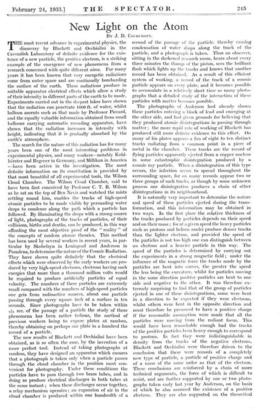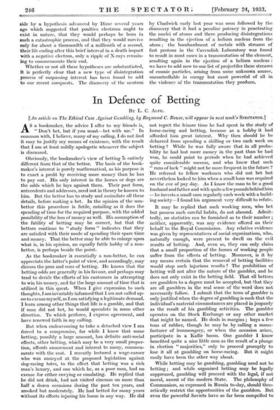New Light on the Atom
BY J. D. COCKCROFT.
THE most recent advance in experimental physics, the discovery by Blackett and Occhialini in the Cavendish Laboratory of definite evidence for the exis- tence of a new particle, the positive electron, is a striking example of the emergence of new phenomena from a research concerned with quite different aims. For many years it has been known that very energetic radiations come from -outer space and are continually bombarding the surface of the earth. These radiations produce in suitable apparatus electrical effects which allow a study of their intensity in different parts of the earth to be made. Experiments carried out in the deepest lakes have shown that the radiation can penetrate 1000 ft. of water, whilst balloon .ascents such as that made by Professor Piccard, and the equally valuable information obtained from small balloons carrying automatic recording apparatus, have shown that the radiation increases in intensity with height, indicating that it is gradually absorbed by the earth's atmosphere.
The search for the nature of this radiation has for many years been one of the most interesting problems in experimental physics, and many workers—notably Kohl- horster and Regener in Germany, and Millikan in America —have been active in the investigation. The most definite information on its constitution is provided by that most beautiful of all experimental tools, the Wilson Cloud Chamber. The Wilson Cloud Chamber, said to have been first conceived by Professor C. T. R. Wilson as he sat on the top of Ben Nevis and watched the mists settling round him, enables the tracks of high-speed atomic particles to be made visible by persuading water drops to condense along the path which a particle has followed. By illuminating the drops with a strong source of light, photographs of the tracks of particles, of their collisions, births and deaths, can be produced, in this way affording the most objective proof of the " reality " of the concepts of modern atomic theories. This method has been used by several workers in recent years, in par- ticular by Skobelzyn in Leningrad and Anderson in Pasadena, to determine the nature of the Cosmic Radiation. They have shown quite definitely that the electrical effects which were observed by the early workers are pro- duced by very high-speed electrons, electrons having such energies that more than a thousand million volts would be required to produce artificially, particles of equal velocity. . The numbers of these particles are extremely small compared with the numbers of high-speed particles one gets from radioactive sources, about one particle passing through every square inch of a surface in ten seconds. Since photographs have to be taken within
sec. of the passage of a particle the study of these phenomena has been rather tedious, the method of previous workers being to expose plates at random, thereby obtaining on perhaps one plate in a hundred the record of a particle.
The new results of Blackett and Occhialini have been obtained, as is so often the case, by the invention of a more perfect tool. Instead of taking photographs at random, they have designed an apparatus which ensures that a photograph is taken only when a particle passes through the cloud chamber in the position most con- venient for photography. Under these conditions the particles have to pass through two brass tubes, and in doing so produce electrical discharges in both tubes at the same instant ; when these discharges' occur together, a relay mechanism operates ; an expansion of air in the cloud chamber is produced within one hundredth of a
second of the passage of the particle, thereby causing condensation of water drops along the track of the particle, and a photograph is taken. Thus an observer, sitting in the darkened research room, hears about every three minutes the thump of the piston, sees the brilliant flash which lights up the tracks and knows that another record has been obtained. As a result of this efficient system of working, a record of the track of a cosmic' particle appears on every plate, and it becomes possible to accumulate in a relatively short time so many photo- graphs that a detailed study of the interaction of these particles with matter becomes possible.
The photographs of Anderson had already shown these particles entering a block of lead and emerging at the other side, and had given grounds for believing that they produced atomic disintegrations in passing through matter : the more rapid rate of working of Blackett has produced still more definite evidence to this effect. On many of his plates appears a fan of eight to ten distinct tracks radiating from a conunon point in a piece of metal in the chamber. These tracks arc the record of flying particles apparently ejected from a copper nucleus in some catastrophic disintegration produced by a cosmic ray particle. When a disintegration of this type occurs, the infection seems to spread throughout the surrounding space, for on many records appear two or three groups of such tracks, as though by some unknown process one disintegration produces a chain of other disintegrations in its neighbourhood.
It is naturally very important to determine the nature and speed of these particles ejected during the trans- formation, and this information may be obtained in two ways. In the first place the relative thickness of the tracks produced by paiticles depends on their speed and on their mass ; for at a given speed the heavy particles such as protons and helium nuclei produce denser tracks than the lighter electron, and provided the speed of the particles is not too high one can distinguish between an electron and a heavier particle in this way. The speed of the particles is determined by carrying out the experiments in a strong magnetic field ; under the influence of the magnetic force the tracks made by the particles are bent into curves, the greater the speed the less being the curvature, whilst for particles moving in the same direction positive particles are bent to one side and negative to the other. It was therefore ex- tremely surprising to find that of the group of particles ejected in one of these disintegrations, some were bent in a direction to be expected if they were electrons, whilst others were bent in the opposite direction and must therefore be presumed to have a positive charge if the reasonable assumption were made that all the particles were moving from the radiant focus. This would have been remarkable enough had the tracks of the positive particles been heavy enough to correspond to protons. In fact they were indistinguishable in density from the tracks of the negative electrons. Blackett and Occhialini were therefore driven to the conclusion that these were records of a completely new type of particle, a particle of positive charge and of a mass of the same order as that of the electron. These conclusions arc reinforced by a chain of more technical arguments, the force of which is difficult to resist, and are further supported by one or two photo- graphs taken early last year by Anderson, on the basis of which he also assumed the existence of a positive electron. They are also supported on the theoretical side by a hypothesis advanced by Dime several years ago which suggested that positive electrons ought to exist in nature, that they would perhaps be born in such a catastrophic process, and that they would survive only for about a thousandth of a millionth of a second; their life ending after this brief interval in a death impact with a negative electron, only a ripple of X-rays remain- ing to commemorate their end.
Whether or not all these hypotheses arc substantiated, it is perfectly clear that a new type of disintegration process of surpassing interest has been found to add to our recent conquests. The discovery of the neutron: by Chadwick -early last- year was soon followed by the discovery that it had a peculiar potency in penetrating the nuclei of atoms and there producing disintegrations resulting in the ejection of a helium nucleus from the atom ; the bombardment of metals with streams of fast protons in the Cavendish Laboratory was found to result in most cases in a transmutation of the element; resulting again in the ejection of a helium nucleus : we have to add now to our list of projectiles theSe streami of cosmic particles, arising from some unknoWn source, uncontrollable in energy but most powerful of all in the violence of the transmutation they produce.







































 Previous page
Previous page